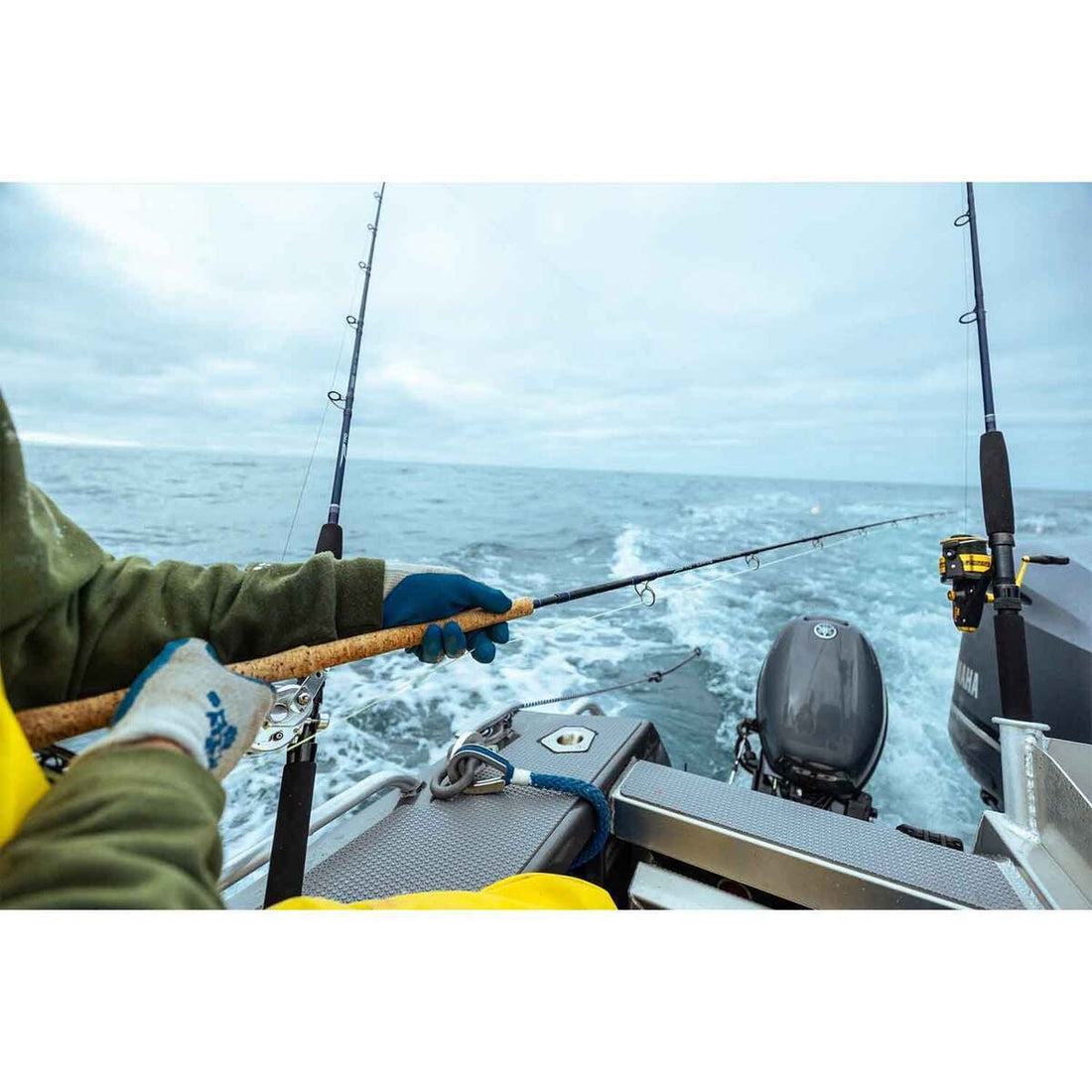
Fishing Rod Guides: The Complete Guide to
Share
The Complete Guide to Fishing Rod Guides: Design, Function, and Importance
Fishing rods may appear simple at first glance—just a flexible shaft with a handle on one end and a tip on the other. Yet, every angler knows that the details make the difference between a tool that simply works and one that elevates the entire fishing experience. Among the most overlooked but critical components of a fishing rod are the guides. These small rings, arranged along the rod’s length, play a massive role in casting performance, line control, sensitivity, and durability.
This article takes an in-depth look at fishing rod guides—their history, materials, designs, functions, and maintenance—explaining why these often-overlooked components deserve more attention. By the end, you’ll understand how guides influence fishing performance and how to select the right ones for your style of angling.

1. What Are Fishing Rod Guides?
Fishing rod guides are circular rings attached along the rod blank, from the handle to the tip. Their primary role is to control and direct the fishing line.
When you cast, the line runs through the guides, which reduce friction and allow smooth line flow. When you hook a fish, the guides distribute the load evenly along the rod, preventing weak points and breakage.
Each rod typically has multiple guides:
* Butt guide (stripper guide): The first guide near the reel, large in diameter, responsible for taming line as it leaves the spool.
* Intermediate guides: Smaller guides placed progressively toward the tip, ensuring line contact and control.
* Tip-top guide: The final, smallest guide at the rod’s tip, critical for casting accuracy and sensitivity.
Without guides, a rod is essentially unusable. They are the “wheels” that make the fishing “vehicle” run.
2. A Brief History of Rod Guides
The history of fishing rod guides is tied closely to the evolution of fishing rods themselves.
* Early rods (pre-1700s): Simple sticks or poles with no guides; lines were tied directly to the tip.
* 18th century Europe: Metal loops began appearing on cane rods, often hand-forged from brass or iron.
* 19th century: As reel technology improved, so did guides. Ring guides with soldered bases became standard on split cane rods.
* 20th century: Introduction of ceramic inserts, such as agate and later aluminum oxide, dramatically reduced line wear.
* Modern era: High-tech materials like titanium, silicon carbide (SiC), and zirconia inserts offer lightness, strength, and low friction. Today’s guides are engineered for specific fishing applications.
From crude rings to precision-engineered components, guides evolved alongside the needs of anglers.
3. Anatomy of a Rod Guide
A rod guide is made up of three key parts:
1. Frame: The metal structure that supports the ring and attaches to the rod blank. Frames are often stainless steel, aluminum, or titanium.
2. Insert (ring): The part that the fishing line runs through. Materials range from budget-friendly aluminum oxide to premium SiC or Torzite.
3. Foot: The flat section of the frame that is wrapped with thread and epoxy to the rod blank. Single-foot and double-foot designs exist, each with pros and cons.
Each part influences the rod’s overall weight, strength, and casting performance.

4. Materials Used in Rod Guides
4.1 Frame Materials
* Stainless steel: Affordable, corrosion-resistant, strong. Standard for most rods.
* Aluminum: Lightweight but less durable than stainless steel.
* Titanium: Premium choice. Strong, ultra-light, and corrosion-proof. Common in high-end saltwater rods.
4.2 Insert Materials
* Plastic or Nylon: Found in very cheap rods; not durable.
* Hard chrome or stainless steel: No inserts, just polished metal. Durable but high friction.
* Aluminum oxide: Affordable ceramic, smooth enough for most fishing lines.
* Silicon carbide (SiC): Extremely hard, smooth, and heat-resistant. Great for braided lines.
* Zirconia: Strong, smooth, and more affordable than SiC.
* Torzite: A Fuji innovation—lightweight, ultra-smooth, expensive.
* Agate/Glass (vintage): Found on classic rods, collectible but less practical today.
The material choice impacts weight, cost, and line wear.
5. Types of Rod Guides
5.1 By Structure
* Single-foot guides: Lighter, used on spinning rods, finesse applications.
* Double-foot guides: Stronger, more stable, used on heavy-duty rods like saltwater or casting rods.
5.2 By Function
* Butt guides (stripper guides): Large, first guide near reel.
* Intermediate guides: Step down in size, control line flow.
* Tip-top guides: The last and smallest guide, critical for accuracy.
5.3 Specialty Guides
* Roller guides: Feature rolling wheels to reduce friction. Popular in big-game trolling rods.
* Micro guides: Tiny guides for casting rods; increase sensitivity and reduce line slap.
* Snake guides: Common on fly rods, shaped like an “S,” lightweight and simple.

6. How Guides Influence Performance
Guides are not just “rings.” They directly impact a rod’s:
6.1 Casting Distance
Smooth, lightweight guides with proper spacing allow line to flow freely, reducing resistance and increasing distance.
6.2 Accuracy
Well-spaced guides keep line close to the blank, preventing erratic line movement and improving accuracy.
6.3 Sensitivity
Lighter, smaller guides enhance sensitivity by transmitting vibrations from the line to the blank.
6.4 Durability
Heavy-duty guides with strong frames and inserts withstand pressure from large fish and abrasive lines.
6.5 Weight Balance
Guide material and size affect rod balance. Titanium micro-guides, for example, lighten the tip, reducing fatigue.
7. Guide Placement and Spacing
Guide placement is as important as material choice. Too few guides cause line slap and stress points; too many add weight.
Rod builders often follow formulas based on rod length, taper, and action. A spinning rod may have 6–8 guides, while a fly rod may have 9–12.
Proper spacing distributes stress evenly, preventing rod breakage and optimizing casting.
8. Fishing Line and Guide Compatibility
Different fishing lines interact with guides differently:
* Monofilament: Works with almost any insert, minimal wear.
* Fluorocarbon: Similar to mono, but slightly stiffer, benefits from smooth ceramic inserts.
* Braided line: Extremely abrasive; requires hard, smooth inserts (SiC, zirconia, Torzite).
* Wire line: Used in trolling; requires roller guides to prevent cutting.
Choosing the right guide for your preferred line is critical.
9. Saltwater vs. Freshwater Rod Guides
Saltwater environments demand corrosion resistance and strength. Titanium frames, double-foot designs, and SiC inserts are common in saltwater rods.
Freshwater rods, by contrast, can use lighter materials like aluminum oxide and single-foot guides, emphasizing sensitivity over brute strength.
Saltwater guides also require more frequent cleaning and maintenance.
10. Maintenance and Care
Proper care extends the life of rod guides:
* Rinse after saltwater use: Always wash rods in fresh water to prevent corrosion.
* Check for cracks: Run a cotton swab through guides to detect chips or cracks that can damage line.
* Avoid impacts: Ceramic inserts can crack if dropped.
* Re-wrap when needed: Guides can be replaced by rod builders if frames bend or inserts crack.
11. Common Problems with Rod Guides
* Cracked inserts: Causes line fraying and break-offs.
* Corrosion: Weakens frames in saltwater conditions.
* Bent frames: Misalign line flow, reducing casting accuracy.
* Loose wraps: Guides may twist or fall off.
Inspecting guides regularly prevents costly line failures.
12. Choosing the Right Guides for Your Rod
When selecting guides, consider:
* Target species: Big-game fish require roller or heavy-duty guides.
* Fishing line: Braid needs harder inserts.
* Rod type: Fly rods use snake guides; spinning rods use large-diameter butt guides.
* Budget: Titanium/Torzite are premium, while stainless/aluminum oxide are affordable.
* Weight vs. durability: Ultralight rods benefit from micro guides, while saltwater rods need strong double-foot guides.
13. Innovations and Trends in Rod Guides
Modern rod building has brought new trends:
* Micro guide systems: Increasingly popular for bass fishing rods.
* Spiral-wrapped guides: Used on casting rods to reduce torque by aligning guides along the rod’s curve.
* Carbon fiber frames: Experimental, offering extreme lightness.
* Hybrid guides: Combining metal frames with polymer inserts for flexibility.
Innovation continues as materials improve and anglers demand higher performance.
14. The Role of Rod Builders
Custom rod builders often highlight guides as one of the most important decisions in rod design. They balance aesthetics, performance, and budget. Many anglers commission custom rods specifically for high-end guide setups—choosing premium titanium frames and SiC inserts for braid-heavy fishing, or lightweight snake guides for fly rods.
Guides are where engineering meets artistry in rod building.
15. Conclusion: The Unsung Heroes of Fishing Rods
Fishing rod guides may seem like small, simple components, but they are the lifelines of rod performance. From casting distance to sensitivity, from line protection to durability, guides make a massive difference in how a rod feels and performs.
Whether you’re building a custom rod, upgrading components, or simply buying your next setup, understanding guides gives you an edge. Choose wisely, care for them properly, and they’ll reward you with smoother casts, fewer line failures, and a better angling experience.
Next time you pick up a rod, take a closer look at the guides—they might just be the most important part of the whole tool.

